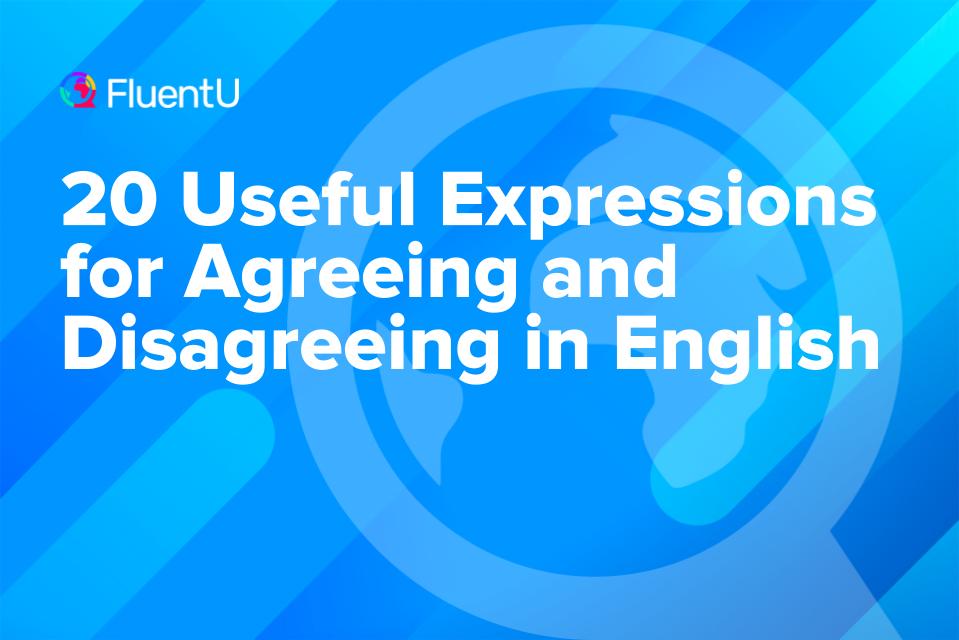Contents
- Agreeing in Conversation: Common Phrases
- 1. I know, right?
- 2. That’s so true!
- 3. Absolutely! / Definitely! / Of course!
- 4. I also think so. / I think so, too.
- 5. I was just going to say that!
- 6. I agree with you a hundred percent. / I agree with you entirely.
- 7. Tell me about it!
- 8. You can say that again!
- 9. You have a point there.
- 10. I have no objections. / I don’t object.
- Disagreeing in Conversation: Common Phrases
- 11. Yes, but…
- 12. No way!
- 13. I beg to differ.
- 14. You can’t be serious!
- 15. That’s not always true. / That’s not entirely true.
- 16. To be honest, I don’t agree with that.
- 17. I think there’s a better explanation.
- 18. As a matter of fact, I don’t think that’s correct.
- 19. I respectfully disagree.
- 20. I think the opposite.
- Tips About Sharing Opinions in English
- And One More Thing...
20 Useful Expressions for Agreeing and Disagreeing in English

There are many ways you can express agreement and disagreement in English, but depending on the situation, some are more appropriate (fitting or correct) than others.
“To agree” means to share the same opinion as someone or to accept their suggestion. “To disagree” means to have a different opinion. So agreeing with someone means you’re telling them that you think the same. You’re disagreeing when you tell them you don’t.
Almost any English conversation you participate in will include having to agree or disagree.
Download: This blog post is available as a convenient and portable PDF that you can take anywhere. Click here to get a copy. (Download)
Agreeing in Conversation: Common Phrases
1. I know, right?
This phrase is used casually and is one of the most common ways to agree in English.
Examples:
This pizza is delicious!
I know, right? The pepperoni is my favorite.
I can’t believe our exam is tomorrow.
I know, right? I’m so nervous!
2. That’s so true!
Examples:
You should treat others how you want to be treated.
That’s so true.
I read an article that said reading before going to bed helps you fall asleep faster.
That’s so true! I’ve tried it before.
3. Absolutely! / Definitely! / Of course!
Examples:
Do you think that eating less meat is better for the environment?
Absolutely!
In my opinion, hard work is the key to success.
Definitely!
If I ask her on a date, do you think she’ll say yes?
Of course! She told my friend that she likes you.
4. I also think so. / I think so, too.
Examples:
I think the meeting room in our office needs more chairs.
I also think so. We have more people than we did last month.
We need to study more for our exam on Monday.
I think so, too. We’ve only reviewed three chapters so far.
5. I was just going to say that!
Examples:
I think we should eat dinner before we go to the movies instead of after.
I was just going to say that!
It’s so cold in here!
I was just going to say that! Let’s turn the A/C off.
6. I agree with you a hundred percent. / I agree with you entirely.
Examples:
Nothing can replace the feeling of reading paper books.
I agree with you a hundred percent.
Honestly, I don’t think we’ve studied enough yet.
I agree with you entirely. I don’t feel prepared.
7. Tell me about it!
This phrase is considered slang and is not typically used in formal English.
Examples:
Taking taxis to work is the most convenient, but it’s so expensive when you do it every day.
Tell me about it! I spent $100 just on taxi rides last month.
That movie was so good!
Tell me about it! It’s the best one I’ve ever seen.
8. You can say that again!
It’s important to note that this phrase isn’t taken literally.
So if you say, “You can say that again,” the other person knows you’re just agreeing with them and don’t actually want them to repeat what they said.
Examples:
That restaurant has the best Mexican food.
You can say that again!
I’m hungry. Let’s go get some food.
You can say that again! I’m starving!
9. You have a point there.
Examples:
I find that when I study my notes with flashcards after I read them again, I remember the terms better.
You have a point there. I’m going to try doing that too.
I’m most inspired to write when I’m outside in nature.
You have a point there. It’s always hard for me to think of new ideas when I’m inside all day.
10. I have no objections. / I don’t object.
This phrase isn’t as common as the others in English. And people usually say it because they don’t have a strong opinion.
It expresses an emotion called indifference—when you don’t really care and have no reason to disagree.
Examples:
I think we should buy pink curtains for our study room.
I have no objections. If you think that color fits the room best, let’s buy it.
What do you think about meeting up at 2 pm instead of 1 pm?
I don’t object. I’m free all day, so whenever works best for you.
Disagreeing in Conversation: Common Phrases
11. Yes, but…
We use this phrase when we agree with the person’s main point, but there’s something preventing us from being able to take action or fully agree with everything they said.
For example:
You’ve been working too much. You should take today off.
Yes, but I have a project due in two days, so I’m trying to get it done as fast as possible.
We should go on a vacation for Spring Break.
Yes, but we don’t really have the money for that right now.
12. No way!
“No way” is more like a way to express shock than to disagree. So when you use it, it’s as if you’re saying, “I can’t believe that!”.
Examples:
I’m really sorry, but I can’t help you work on the project tonight. I forgot I had plans.
No way! You’re joking with me, right?
Kelly says that she can run a mile in five minutes.
No way! That would mean she’s faster than Melissa.
13. I beg to differ.
We usually say “I beg to differ” when we disagree with someone because of past experiences we’ve had.
Examples:
Running is easy.
I beg to differ. Every time I run, I get out of breath after only five minutes.
Cats are better pets than dogs.
I beg to differ. I’ve had cats before, and they were nowhere near as fun as my dog.
14. You can’t be serious!
Like “No way,” this phrase is used to express shock or disbelief.
Examples:
I think we should stop trying to form a band. No one listens to this style of music anymore.
You can’t be serious!
Buying a house is useless in this economy. I’d rather rent.
You can’t be serious!
15. That’s not always true. / That’s not entirely true.
Examples:
Exercising is the best way to lose weight.
That’s not entirely true. Without a healthy diet, you won’t lose any weight.
The CEO has the easiest job in the company. He doesn’t have to come to work like we do.
That’s not always true. He’s under a lot of stress trying to make sure the business keeps making money.
16. To be honest, I don’t agree with that.
Examples:
We should increase the fine for people who leave trash on the ground.
To be honest, I don’t agree with that. There’s already a $500 fine, so raising it won’t make a difference.
Skateboarding is a lot safer than riding a bike.
To be honest, I don’t agree with that. I know more people who have had skateboarding accidents than bike accidents.
17. I think there’s a better explanation.
Examples:
Our profits are down this year because our employees are taking too many coffee breaks.
I think there’s a better explanation. Maybe profits are down because our new website keeps crashing.
I don’t think I did well on the test because I’m not very smart.
I think there’s a better explanation. Maybe you didn’t do well on the test because you never went to class.
18. As a matter of fact, I don’t think that’s correct.
This is another formal way of disagreeing with someone.
Examples:
There’s no use in learning new things once you’re old.
As a matter of fact, I don’t think that’s correct. It’s been proven a myth that you can’t learn new things after a certain age.
Our sales dropped by 18% last month.
As a matter of fact, I don’t think that’s correct. I looked at the report, and we actually increased sales last month.
19. I respectfully disagree.
This is a good way to politely but firmly voice your opinion.
Examples:
This isn’t a very good strategy.
I respectfully disagree. What do you think is wrong with it?
This film doesn’t live up to its reputation.
I respectfully disagree. I thought it was the best film this director has ever made.
20. I think the opposite.
This can be a respectful way to show that your opinion is entirely different from the other person’s.
Examples:
I think that romance movies are better than horror movies.
I think the opposite.
I think Catherine is funnier than Robert.
I think the opposite.
Tips About Sharing Opinions in English
Indicate that you’re sharing your opinion
Agreements and disagreements are generally your personal thoughts and feelings about something.
Phrases like “I think” or “in my opinion” make it clear that you’re stating an opinion and not a fact.
For more phrases like these, take a look at this post:
65 Useful Phrases for Expressing Opinions in English | FluentU English Blog
Expressing your opinion in English is important. It’s how you have meaningful conversations, learn about other people and describe your feelings. Read this post to find 65…
Find more phrases to use on the FluentU program, where you learn new vocabulary naturally with native English videos.
FluentU takes authentic videos—like music videos, movie trailers, news and inspiring talks—and turns them into personalized language learning lessons.
You can try FluentU for free for 2 weeks. Check out the website or download the iOS app or Android app.
P.S. Click here to take advantage of our current sale! (Expires at the end of this month.)

Using these phrases helps create a friendly environment where both people feel that they can talk openly and share their opinions.
Ask for feedback
Questions like “What do you think?” also helps the other person feel like you’re open to a discussion and care about their opinions.
Be polite
Even if you disagree, you can still be polite and respectful.
Phrases like “I might be wrong, but…” or “I am sorry, but I don’t agree” help to maintain politeness and respect.
Try to address the thought instead of the person
Differences in thought and opinion don’t need to affect your relationship with people.
This is especially important in academic and office spaces. Remember, you’re agreeing or disagreeing with the opinion, thought or idea.
“I say this with due respect, but…” is a nice way to state a disagreement, especially in a professional or formal setting.
Know when to end the conversation
Ending a conversation when it becomes too uncomfortable or the other person repeats the same points is a good idea.
It indicates that the person isn’t really interested in changing their mind or accepting your different point of view, so continuing the conversation is pointless.
In these situations, you should agree to disagree and move on.
Agreements and disagreements are a big part of most discussions.
Learning some simple ways to agree and disagree in English will help you improve your conservation skills and be able to participate in discussions with native English speakers.
Download: This blog post is available as a convenient and portable PDF that you can take anywhere. Click here to get a copy. (Download)
And One More Thing...
If you like learning English through movies and online media, you should also check out FluentU. FluentU lets you learn English from popular talk shows, catchy music videos and funny commercials, as you can see here:
The FluentU app and website makes it really easy to watch English videos. There are captions that are interactive. That means you can tap on any word to see an image, definition, and useful examples.
For example, when you tap on the word "searching," you see this:
Learn all the vocabulary in any video with quizzes. Swipe left or right to see more examples for the word you’re learning.

FluentU helps you learn fast with useful questions and multiple examples. Learn more.
The best part? FluentU remembers the vocabulary that you’re learning. It gives you extra practice with difficult words—and reminds you when it’s time to review what you’ve learned. You have a truly personalized experience.
Start using the FluentU website on your computer or tablet or, better yet, download the FluentU app from the iTunes or Google Play store. Click here to take advantage of our current sale! (Expires at the end of this month.)










